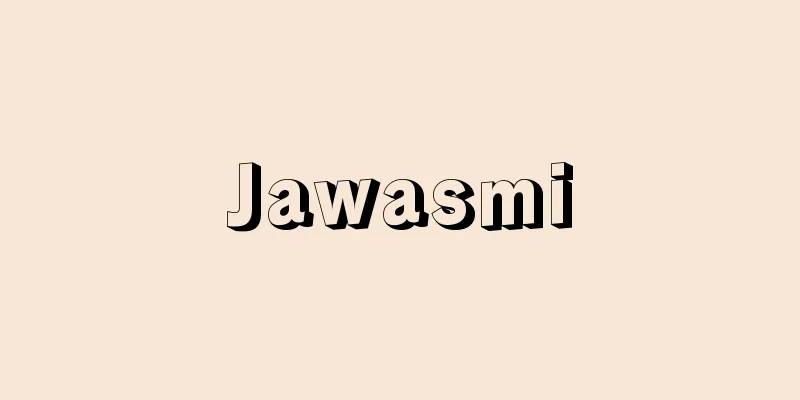Atomic weight - genshiryo (English spelling) atomic weight

|
A value that represents the mass of an atom of each element. However, since the absolute value is extremely small, a certain number of atoms of one element is used as the standard, and all values are shown relative to that. The atomic weight currently used was announced as the unified atomic weight in 1962 by the International Union of Pure and Applied Physics (IUPAP) and the International Union of Pure and Applied Chemistry (IUPAC), and adopted by the International Commission on Atomic Weights (ICAW, now the Commission on Isotopic Abundances and Atomic Weights CIAAW), which uses carbon-12, one of the carbon isotopes, as the standard, with an atomic weight of 12.00000. In other words, if 6.0221367× 1023 (Avogadro's constant) carbon atoms were gathered together, their mass would be 12.01115 grams, while the masses for hydrogen and oxygen are 1.00797 grams and 15.9994 grams, respectively. Since atomic weights are constantly being measured precisely, new values are published by the CIAAW every two years. [Nakahara Katsunori] How to determine atomic weightThe concept of atomic weight was first introduced in 1803 by John Dalton of England in his atomic theory, and the first atomic weight table was published in 1805. However, these values were not very accurate, and afterwards, a fairly precise measurement was carried out by Berzelius of Sweden, providing experimental support for the atomic theory. Many studies and measurements were carried out after that, but there was always confusion between atomic weight, equivalent weight, and molecular weight, and in 1860, the foundation of modern atomic weight measurement was first laid by Cannizzaro of Italy. During this time, there were many further changes, and at first, oxygen was used as the standard because oxygen forms many compounds, and the atomic weight of oxygen was set at 1, 10, or 100, or hydrogen was used as the standard and set at 1, but since the International Atomic Weight Commission was established at the end of the 19th century, oxygen has been used as the standard, and the atomic weight of oxygen has been set at 16.00000. In other words, oxygen atoms that exist in nature have three isotopes: oxygen-16, oxygen-17, and oxygen-18, which are mixed in a certain ratio. Chemistry used the average relative mass of the three isotopes as 16.00000, which was used as the chemical atomic weight. In contrast, oxygen-16 was used as the physical atomic weight as 16.00000. The ratio of the physical atomic weight to the chemical atomic weight was 1.000272 ± 0.000005, which could be ignored. However, as detailed research progressed, the irrationality and inconvenience of this gradually became apparent, and the unified atomic weight was adopted by both the International Union of Physics and Chemistry. [Nakahara Katsunori] [References] | | | [Supplementary information] |Source: Shogakukan Encyclopedia Nipponica About Encyclopedia Nipponica Information | Legend |
|
各元素の原子の質量を表す値。ただし絶対値がきわめて小さいので、一つの元素の原子をある一定数として基準にとり、すべてそれに対する相対的な値で示す。現在用いられている原子量は、国際純粋・応用物理学連合(IUPAP:International Union of Pure and Applied Physics)と国際純正・応用化学連合(IUPAC:International Union of Pure and Applied Chemistry)が、1962年統一原子量として発表し、国際原子量委員会(ICAW=International Commission on Atomic Weights、現、原子量および同位体存在度委員会CIAAW=Commission on Isotopic Abundances and Atomic Weights)が採用したもので、炭素の同位体のうち、炭素12を基準にとり、これを原子量12.00000としたものである。すなわち炭素原子が6.0221367×1023(アボガドロ定数)個集まれば、その質量は12.01115グラムで、同じく水素、酸素ではそれぞれ1.00797グラム、15.9994グラムである。原子量はつねに精密測定がなされているため、それらの値はCIAAWから2年に一度、新しい値が発表されている。 [中原勝儼] 原子量の決め方原子量の概念は、1803年イギリスのJ・ドルトンの原子説によって初めて導入され、1805年に最初の原子量表が発表されている。しかしこの値はあまり正確ではなく、その後スウェーデンのベルツェリウスによってかなり精密な測定が行われ、原子説にいちおうの実験的支持が与えられた。その後も多くの研究、測定が行われたが、つねに原子量、当量、分子量間の混乱があり、1860年に至りイタリアのカニッツァーロによって初めて近代的原子量測定の基礎が築かれた。この間さらに幾多の変遷があり、初めは酸素が多くの化合物をつくることから酸素を基準にとり、酸素の原子量を1あるいは10または100などとしたり、水素を基準にとり1とすることもあったが、19世紀の末に国際原子量委員会がつくられたころから酸素を基準にとり、酸素の原子量を16.00000と定めていた。すなわち、自然界に存在する酸素原子には、酸素16、酸素17、酸素18の3種の同位体があり、それらが一定の割合で混合している。この三つの同位体の混合しているものを平均し、16.00000を平均相対質量としたものを化学では用い、これを化学的原子量としていた。これに対し、酸素16を16.00000としたものを物理的原子量としていた。物理的原子量と化学的原子量の比は1.000272±0.000005で、無視しても差し支えなかった。しかし精密な研究が進むにつれ、不合理さと不便さがしだいに明らかになり、統一原子量が物理学および化学の両国際連合によって採用されることになった。 [中原勝儼] [参照項目] | | | [補完資料] |出典 小学館 日本大百科全書(ニッポニカ)日本大百科全書(ニッポニカ)について 情報 | 凡例 |
>>: Envoy to Silla - Kenshiragishi
Recommend
Electrophoresis
In the past, it meant that when a pair of electro...
《Jeune Belgique》(English spelling)
… 【culture】 In the area that is now Belgium, from...
Intersubjective constructivism
...This, combined with the knowledge of quantum m...
lion's tail
...The ones that produce beautiful flowers are cu...
POLAMAZONIA
…In addition to this transverse road, other roads...
Udegeitsy
...Population: 1900 (1989). Russians call them Ud...
Dirk Brouwer
1902‐66 American astronomer. Born in the Netherlan...
Eastern Canada - Kanada Ubu
...The political and economic ruling class was Br...
General birth rate - Ippanshūsseiritsu
...However, in reality, the denominator P does no...
Cheers - Cheers
...A singer who left the greatest mark on the his...
House sparrow (house sparrow)
A passerine bird of the Weaverbird family (illustr...
Büchner, Georg
Born: October 17, 1813. Godderau German playwright...
Istiqlāl (English spelling)
...In the 1930s, as armed resistance was suppress...
Denenchofu
This district is located in the northwestern edge...
Wool (English spelling)
Wool. A fiber used to make yarn and woolen fabrics...









